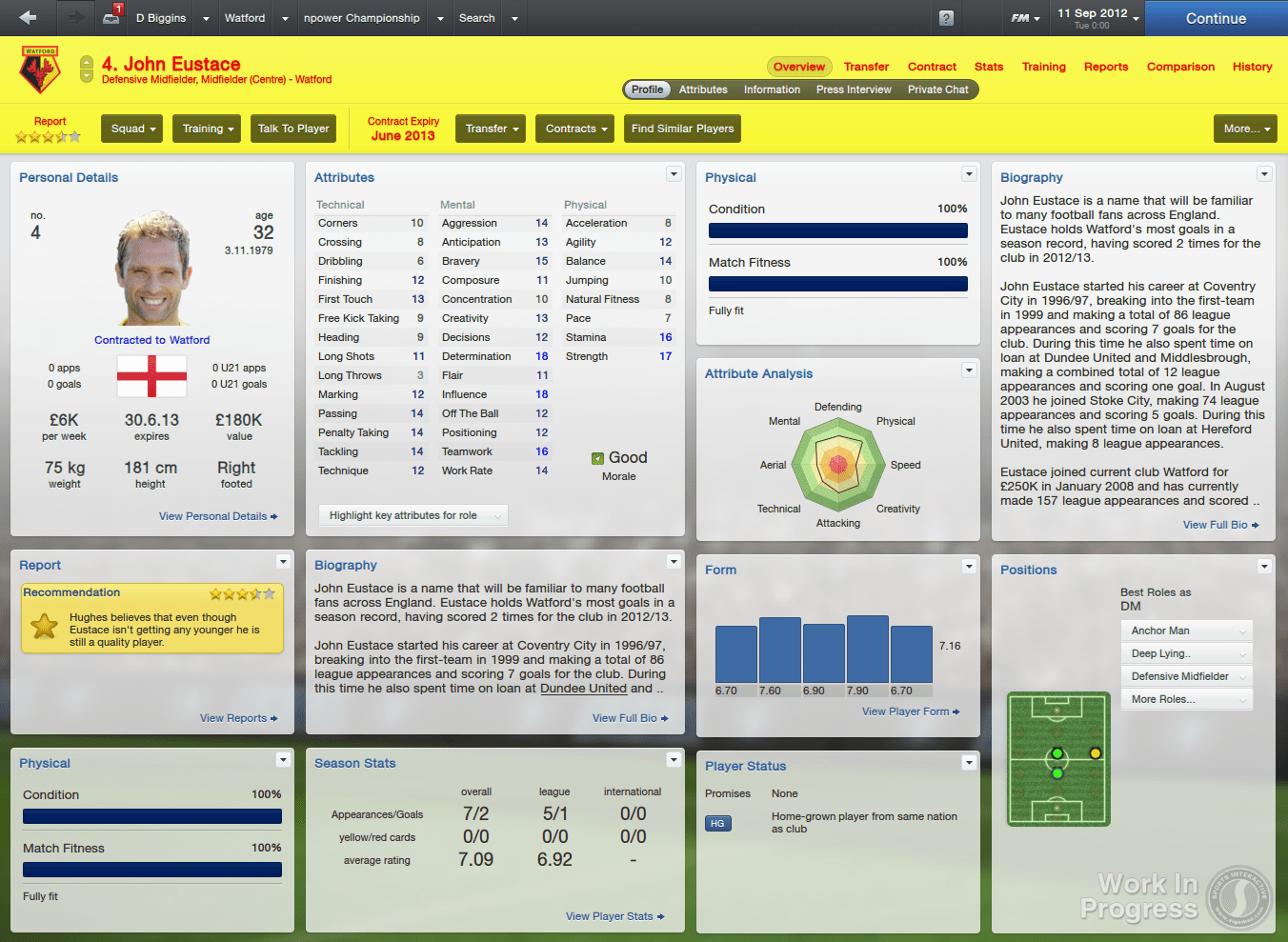Our Review of Football Manager 2013
Still catering to the obsessed, but now with more to offer casual players.
There’s no such thing as a worldwide holiday for fans of soccer sims (or football, if you prefer), but if there was, it would probably be the day a new iteration of the Football Manager series goes live. As it always does, Sports Interactive’s labor of love attempts to capture the beautiful game, and specifically, managing a club or national team in pretty much any country that plays soccer, in more detail than any other title would dare to try. But while hardcore fans have a few new things to look forward to in Football Manager 2013 (FM2013), the big focus for the latest release is a host of features designed to help people who aren’t longtime devotees give the game a shot.
That’s not necessarily a bad thing, as one of the traits shared by the last decade or so of Football Manager games is their daunting, all-consuming complexity. Any good sports sim can be a time sink, but not many can tie up hours of your life in-between each match. Let’s just say there’s a good reason why memes popped up about wives threatening to leave their husbands over too much time spent with Football Manager.
To combat the problem of marriage-wrecking commitment, FM2013 introduces a whole new way to play with Football Manager Classic. This mode is different enough that it could be (and almost was, according to the developers) its own distinct game, but it’s essentially a way to enjoy the experience of running your own team without several layers of the details that the series has built up over the years.
The interface for Football Manager Classic is the first thing that grabs your attention. Though it’s similar to the one used by the full-featured mode, it’s easier to read – literally, as the font for every screen is bigger – and much of the information is presented in a more intuitive, highly visual fashion. Important bits of news still come to your inbox, but the game also summarizes tidbits from around the world of soccer and presents them in a newsletter, where you can click on any story and blow it up in its own pop-up window.
That world is smaller, too, as launching a new career in Football Manager Classic allows you to choose just three countries in which to ply your trade. This helps things simulate at a much faster pace, as does the simplified gameplay. There’s less of an emphasis on training, and the tactical options are also streamlined a bit. Media interaction is limited to single questions that go straight to your inbox. Matches can still be played in the 3D engine, so there’s nothing missing from the match day experience.
The FM2013 team has been quick to point out in interviews that the Classic mode is different than just allowing the assistant manager to handle tasks you’d rather not sully yourself with in standard mode, as those aspects of the game are actually removed from play altogether. The goal is to enable players to get through a whole season in a relatively sane amount of time, and it succeeds beautifully on that front. Whether realism suffers as a result of the streamlining remains to be seen, but it’s easy to imagine people who just want to win a league title with their favorite club team making this their preferred mode.
Hardcore sim fans will probably take a less enthusiastic view of something else that Football Manager Classic introduces to the series, which is an in-game store. The idea of having additional content purchases on top of a full-priced game is controversial enough, but some of the items on sale here really do let players “cheat” the game: An option to see all the players in the game without scouting them, an automatic override of a boardroom decision, and even a direct infusion of transfer funds, to name a few. Most of these boosts can be unlocked by accomplishing certain goals while playing, but their presence alone seems like it has the potential to be a divisive topic.
FM2013 also offers another way to play in smaller chunks of time by borrowing the challenges from Football Manager Handheld. These are relatively short scenarios requiring you to complete a specific task, like saving a floundering team from relegation or living up to the board’s goals despite suffering a nasty rash of injuries. A fifth challenge is already available through the in-game store, which makes sense as a method of delivering even more content down the road.

Long term or to the transfer market?
The standard Football Manager mode also got plenty of attention from Sports Interactive, though most of it feels like it was in the 3D match engine. Along with improved animations that add a greater sense of realism to the action on the pitch, a series of drop-down menus at the top of the screen make it easier than ever to adjust tactics or make substitutions on the fly. Pop-up windows announce bookings and other events during simmed portions of the match, and scoring updates from other games going on at the same time let you know if you are moving up or down the table. Real time advice from your assistant manager and ongoing updates on your players’ body language give you even more guidance on what moves to make.

More in-depth Game Play
As always, FM2013 has done extensive research on leagues all over the world, and you can choose to manage in over 50 countries. Individual player training has been redone to allow each athlete’s regimen to be controlled in fairly exhaustive detail. Press conferences and player interactions have sadly received few tweaks aside from the choice of tone you use when addressing people (calm, reluctant, passionate, aggressive, etc.), and a wider range of questions from the media is at the top of this reviewer’s wish list for next year. As it stands, talking to the press is kind of a catch-22 – too important to team morale to skip but too tedious to be fun.
Transfer negotiations haven’t changed too much either, with the exception of a little more insight into how different agents affect the process. The Football Manager games have always handled the transfer business in admirably realistic fashion, no small task considering how crazy it can get in real life. Many players routinely turn their noses up at leagues they consider beneath them, and it’s not hard to find others who have inflated senses of their own worth. Taxes have been added to the game’s financial model to keep rich teams from abusing the system too much, something supporters of smaller clubs no doubt wish would happen more in the actual sport.
Both the standard and Classic modes can be played online against other human managers, and the game’s Steam integration makes it easier than ever to find a league to join. SI also added Versus mode for quicker head-to-head action, including tournaments of up to 32 teams and small leagues of two to six teams. It’s not quite a substitute for the late, lamented Football Manager Live (lamented by this reviewer anyway), but it is the widest array of online options we’ve seen in the series to date.
About the only thing that remains absent from FM2013 is the player likenesses and logos from the Premier League, the UEFA Champions League and a few other competitions, as their rights remain tied up in other games. Fortunately it’s easy to get them into your copy of the game, as the community of modders to assist you with image files remains active and vibrant.
Soccer arguably depends on stats less than any other major sport, so it can’t be easy to create a soccer sim that is heavy on realism while also remaining fun to play. Somehow Sports Interactive has been pulling it off for years, and with the additions to FM2013 making it more playable than ever, it should remain as addictive as ever this season.
